#and the other is designed to be perpetually ongoing
Text
so in oxygen i’d kinda been jumping from festival to festival just because those are the most interesting things that happen but um . i don’t think i’m gonna do the 1.6 festivals, first off because i haven’t gotten far enough in my 1.6 farm to have actually played them, and second because the next one is the fucking. trout derby
#.txt#which does mean technically the next chapter should be the dance of the moonlight jellies#BUT i kinda wanna do a chapter inbetween to get back into the groove of things#and also i think maybe skipping the bits between festivals makes everything like#way faster than i want it to be#god this makes this my third currently active fanfic project#to be fair one is almost done because i’ve been chipping away at it for over a year#and the other is designed to be perpetually ongoing#but Still#oh well i really love this au still and i’m gonna push myself to finish it#since i’m on a roll with writing recently
9 notes
·
View notes
Text
"Wisconsin Gov. Tony Evers (D) has vetoed a Republican-led ban on transgender high school athletes, saying that such legislation would needlessly harm the mental well-being of trans youth and make the state less safe for LGBTQ+ people. State Republicans reportedly lack the votes to override his veto.
“This type of legislation, and the harmful rhetoric we get by pursuing it, harms LGBTQ Wisconsinites’ and kids’ mental health, emboldens anti-LGBTQ harassment, bullying, and violence, and threatens the safety and dignity of LGBTQ Wisconsinites, especially our LGBTQ kids,” Evers wrote in his veto message.
“I am vetoing this bill in its entirety because I object to codifying discrimination into state statute and the Wisconsin state legislature’s ongoing efforts to perpetuate hateful and discriminatory rhetoric and policies targeting LGBTQ Wisconsinites including our transgender and gender nonconforming kids…. I will veto any bill that makes Wisconsin a less safe, less inclusive, and less welcoming place for LGBTQ people and kids,” Evers added.
He vetoed the bill in a public ceremony while surrounded by trans advocates, Democratic lawmakers, the mayor of Madison and others, NBC News reported.
The bill would have required public, private, and independent charter schools to designate each team by the gender of its participants, and then require participants to play on teams matching the gender listed on their birth certificates.
The bill would have overruled current policies, established in 2015 by the Wisconsin Interscholastic Athletic Association, that allowed trans students to play on sports teams matching their gender identity as long as they provided a personal letter; supporting documentation from parents, teachers, and medical professionals; and proof of any gender-affirming care...
Last September [in 2023], Evers vetoed a Republican-led bill that would’ve banned gender-affirming medical care for minors."
-via LGBTQ Nation, April 2, 2024
#voting matters#tony evers#democrats#united states#us politics#transgender#trans issues#trans sports#trans kids#lgbtq#lgbtq issues#queer issues#trans positivity#lgbtq positivity#wisconsin#republicans#public schools#good news#hope
988 notes
·
View notes
Text
Writers Against the War on Gaza (WAWOG) is an ad hoc coalition committed to solidarity and the horizon of liberation for the Palestinian people. Drawing together writers, editors, and other culture workers, WAWOG hopes to provide ongoing infrastructure for cultural organizing in response to the war. This project is modeled on American Writers Against the War in Vietnam, an organization founded in 1965.
Statement of Solidarity
October 26, 2023
Israel’s war against Gaza is an attempt to conduct genocide against the Palestinian people. This war did not begin on October 7th. However, in the last 19 days, the Israeli military has killed over 6,500 Palestinians, including more than 2,500 children, and wounded over 17,000. Gaza is the world’s largest open-air prison: its 2 million residents—a majority of whom are refugees, descendants of those whose land was stolen in 1948—have been deprived of basic human rights since the blockade in 2006. We share the assertions of human rights groups, scholars, and, above all, everyday Palestinians: Israel is an apartheid state, designed to privilege Jewish citizens at the expense of Palestinians, heedless of the many Jewish people, both in Israel and across the diaspora, who oppose their own conscription in an ethno-nationalist project.
We come together as writers, journalists, academics, artists, and other culture workers to express our solidarity with the people of Palestine. We stand with their anticolonial struggle for freedom and for self-determination, and with their right to resist occupation. We stand firmly by Gaza’s people, victims of a genocidal war the United States government continues to fund and arm with military aid—a crisis compounded by the illegal settlement and dispossession of the West Bank and the subjugation of Palestinians within the state of Israel.
We stand in opposition to the silencing of dissent and to racist and revisionist media cycles, further perpetuated by Israel’s attempts to bar reporting in Gaza, where journalists have been both denied entry and targeted by Israeli forces. At least 24 journalists in Gaza have now been killed. Internationally, writers and cultural workers have faced severe harassment, workplace retribution, and job loss for expressing solidarity with Palestine, whether by stating facts about their continued occupation, or for amplifying the voices of others. These are instances that mark severe incursions against supposed speech protections. Specious charges of antisemitism are leveled against Zionism’s critics; political repression has been particularly aggressive against the free speech of Muslim, Arab, and Black people living in the US and across the globe. As was the case following the September 11th attacks, Islamophobic political fervor and the widespread circulation of unsubstantiated claims has galvanized a US-led coalition of military support for a brutal campaign of violence.
What can we do to intervene against Israel’s eliminationist assault on the Palestinian people? Words alone cannot stop the onslaught of devastation of Palestinian homes and lives, backed shamelessly and without hesitation by the entire axis of Western power. At the same time, we must reckon with the role words and images play in the war on Gaza and the ferocious support they have engendered: Israel’s defense minister announced the siege as a fight against “human animals”; even as we learned that Israel had rained bombs down on densely populated urban neighborhoods and deployed white phosphorus in Gaza City, the New York Times editorial board wrote that “what Israel is fighting to defend is a society that values human life and the rule of law”; establishment media outlets continue to describe Hamas’s attack on Israel as “unprovoked.” Writers Against the War on Gaza rejects this perversion of meaning, wherein a nuclear state can declare itself a victim in perpetuity while openly enacting genocide. We condemn those in our industries who continue to enable apartheid and genocide. We cannot write a free Palestine into existence, buttogether we must do all we possibly can to reject narratives that soothe Western complicity in ethnic cleansing.
We act alongside other writers, scholars, and artists who have expressed solidarity with the Palestinian cause, drawing inspiration from the Palestinian spirit of sumud, steadfastness, and resistance. Since 2004, the Palestinian Campaign for the Academic and Cultural Boycott of Israel (PACBI) has advocated for organizations to join a boycott of institutions representing the Israeli state or cultural institutions complicit with its apartheid regime. We call on all our colleagues working in cultural institutions to endorse that boycott. And we invite writers, editors, journalists, scholars, artists, musicians, actors, and anyone in creative and academic work to sign this statement. Join us in building a new cultural front for a free Palestine.
Signed,
WAWOG Interim Organizing Committee
Hannah Black
Ari Brostoff (Senior Editor, Jewish Currents)
Elena Comay del Junco
Kyle Dacuyan (Executive Director, Poetry Project)
Kay Gabriel (Editorial Director, Poetry Project)
Kaleem Hawa
E. Tammy Kim
Shiv Kotecha
Wendy Lotterman (Associate Editor, Parapraxis)
Muna Mire
Perwana Nazif
Brendan O'Connor
Alex Press (Staff Writer, Jacobin)
Sarah Nicole Prickett
Dylan Saba
Zoé Samudzi (Associate Editor, Parapraxis)
Jasmine Sanders
Claire Schwartz (Culture Editor, Jewish Currents)
Janique Vigier
Harron Walker
Chloe Watlington
Gabriel Winant (Department of History, University of Chicago)
Audrey Wollen
Hannah Zeavin (Founding Editor, Parapraxis)
Signed, In Solidarity
Fatimah Warner (Noname)
Saul Williams
Susan Sarandon
Janeane Garofalo
Gael García Bernal
Danez Smith
Ocean Vuong
Aria Aber
Saidiya Hartman
China Miéville
+ full list here
#writers against the war on gaza#wawog#free palestine#this letter is the one#you know how i encountered this when you see one of the people who signed#text#noname#susan sarandon#saul williams#gael garcia bernal#ocean vuong#joel kim booster#what a pleasant surprise#patti harrison#fariha roisin#zoe samudzi
237 notes
·
View notes
Text

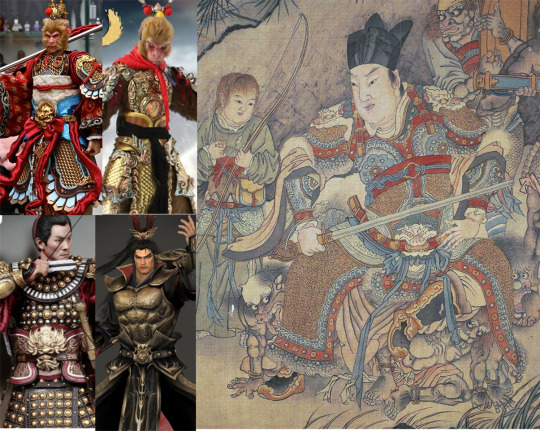

Shihouin[四楓院] Chika[千日]
Shi[四]: "4"
Hou[楓]: "Maple(tree)"
In[院]: "Temple/House(of governmetn)/Institution"
Chi[千]: "1,000"
Ka[日]: "(The)Sun"/"Day"
Given the naming pattern with Yoruichi and Yuushirou reading "Night 1" and "Night 4 Son", it would follow that Chika's name here reads as "1000 Days" or "1000th Day" A curious notion when the Shihouin crest has a moon on it, which was obviously where the night motif in the later heirs came from. Is Chika a blacksheep of the family for not having a night name? Or did the Shihouin change their motif at some point from day/sun to night/moon?
And very noticeably he's wearing what looks like a chinese style of lamellar belt(it's hard to say when there isn't an accompanying suit of armor to go with it) but it evokes to me a lot of Ming dynasty period pieces(or alternatively very anime-ass Romance of the Three Kingdoms designs) and incidentally Journey To The West was written in the Ming Dynasty, and combined with his complexion and his distinctive Xiangyun[祥云]:"auspicious clouds" scarf (and of course my ongoing crackpot theory about there being an unspoken theme of pre-Japanese Buddhism underlying the foundation of Soul Society) makes me think he's specifically Indian but having travelled East across China(or whatever the Soul Society equivalents are)


Izuhara[嚴原] Kinroku[金勒]
Izu[嚴]: "Strict/Stern"
Hara[原]: "Plain/Field/Wilderness"
Kin[金]: "Gold"
Roku[勒]: "Bit/Bridle(like a horse's)"
Makes him sound like a wild stallion type who was only tamed by being bribed with wealth and luxury. At first glance I had pegged him for a cold corporate or medical type, but looking at him again he has a certain yakuza look about him too. Less an overt thug and more a grifter, a penny pincher, a coldblooded loan shark type, and this name seems to vibe with that. It's hard to tell but it looks like he has the archetypal yakuza/laborer bellywarmer like Tetsuzaemon did too.
Shijima[志島] Chikiri[知霧]
Shi[志]: "Will/Resolution/Ambition"
Jima[島]: "Island"
Chi[知]: "Wisdom/jnana"
Kiri[霧]: "Mist/Fog/Haze"
Same root word Shi[志] as in the Shiba family and in Okikiba Genshiro's given name. Weird that all three of these are associated with the water; waves/ripples, islands, and distant waters.
The given name is fun because it seems to describe him as wise but in a hazy way, his wisdom is obscured or unclear; whether that means it's unclear to others, or even to him isn't clear. Either one seems to fit his kind of disheveled appearance.
Now that we can see him properly, he kind of reminds me of Wonderweiss.




Obana[尾花] Danjirou[彈児郎]
O[尾]: "Tail"
Bana[花]: "flower"
Dan[彈]: "Bullet/Pellet/(musket)Ball"
Ji[児]: "newborn baby"
Rou[郎]: "son"
On the one hand the compound [尾花] appears to refer to "(ear of) Japanese pampas grass" which is also known as the Chinese Silver Grass. But it's also part of the compound [鸟尾花] refering to the Crossandra infundibuliformis, the Firecracker Flower. And also [鸢尾花] referring to irises in general. Since, as the 5th division captain, he's not the one with an iris insignia, I'm going to go with the silver grass reference. It does evoke a certain rugged and pastoral landscape that seems to suit the rustic almost hick-ish vibe he has going on.
As for Bullet baby.... I have no idea what to make of it...
Saitou[齊藤] Furofushi[不老不死]
[齊]: "...-Like/as if..."
[藤]: "Wisteria"
[不老]: "No grow old"
[不死]: "No die"
"Wisteria-like" has obvious evocations in her hair color and pigtails. The given name all together is actually a phrase meaning "immortality/perpetual youth." Pretty straight forward.
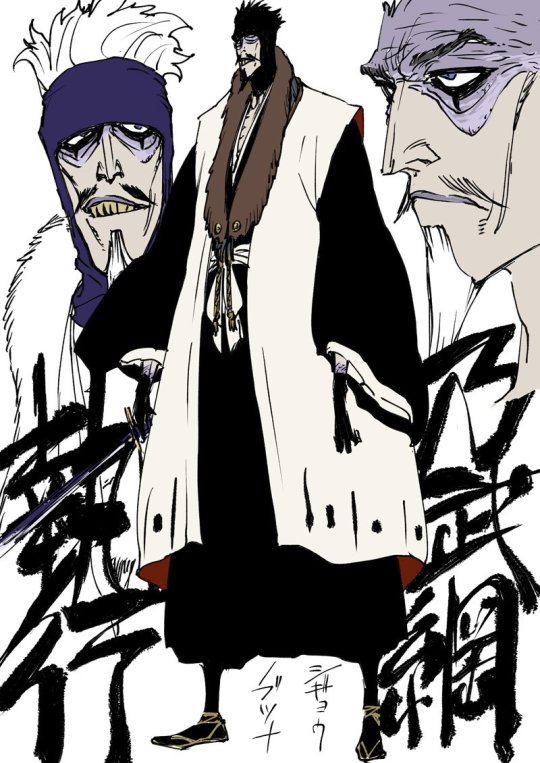
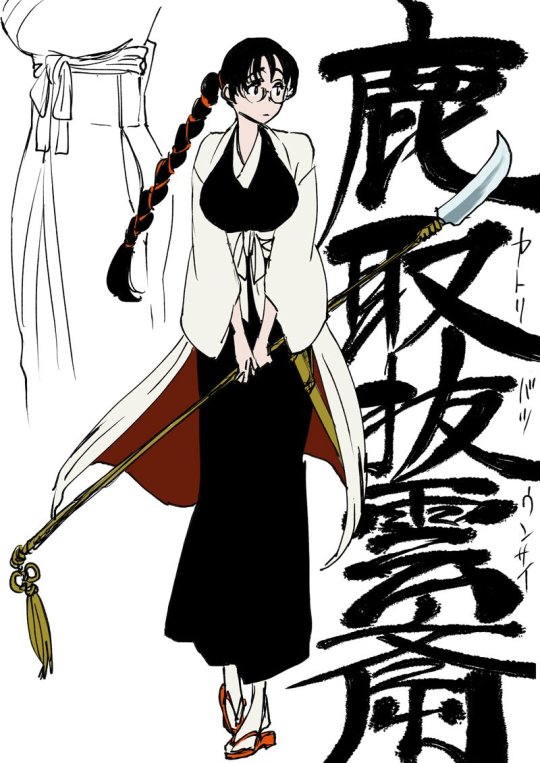

Shigyou[執行] Nobutsuna[乃武綱]
Shigyou[執行]: "execution/enforcment"/"executive/executor"*
No[乃]: "<possessive indicator>"
Bu[武]: "Military/Martial"
Tsuna[綱]: "Cord/Rope"
*can also refer to a "lead monk performing various tasks in a (buddhist)temple" although his overall appearance is anything but monk-like; certainly there are other captains here that would suit that reading better. So, the "rope or military enforcement."
(The random 3rd division guy with the "Winter Whistle" sword was named Taketsuna[武綱])
Katori[鹿取] Batsuunsai[抜雲齋]
Ka[鹿]: "Deer"
Toribatsu[取抜]: "Drain/Extract"
Un'[雲]: "Cloud"
Sai[齋]: "<indicates a penname>"
Ok, first of all... "Deer Extraction"??? And then her given name is either "Penname: Cloud" or if taken together [雲齋]: "cotten drill" as in the twill weave fabric used for things like khakis?? But that feels like a weird way to go. She is quite bookish looking (i mean... as if she can avoid it in the proximity of Nanao and Risa...) so perhaps she's an author on the side? Hence the penname. But as for the deer collecting... it feels like a weird way to phrase it, but I'm assume it's trying to conjure a disney princess-like scene of her attracting deer to her to show her purity and trustworthiness? Maybe???
Also she has a distinctive, Zhōngguó jié[中國結]: "Chinese knot" ornament at the end of her naginata(?) which wasn't shown in the poster. Although the coloration on this sheet is oddly gold rather than the more typical red. What is probably the most common and recognizable design is the Pán zhǎng jié[盤長結], sometimes called an "endless knot" or "eternal knot" and is used to represent various Buddhist virtues.
[edit]: so i changed the split on the first and last name according to what seems like the confirmed canon, but I stand by "batsuunsai" sounding extremely weird.
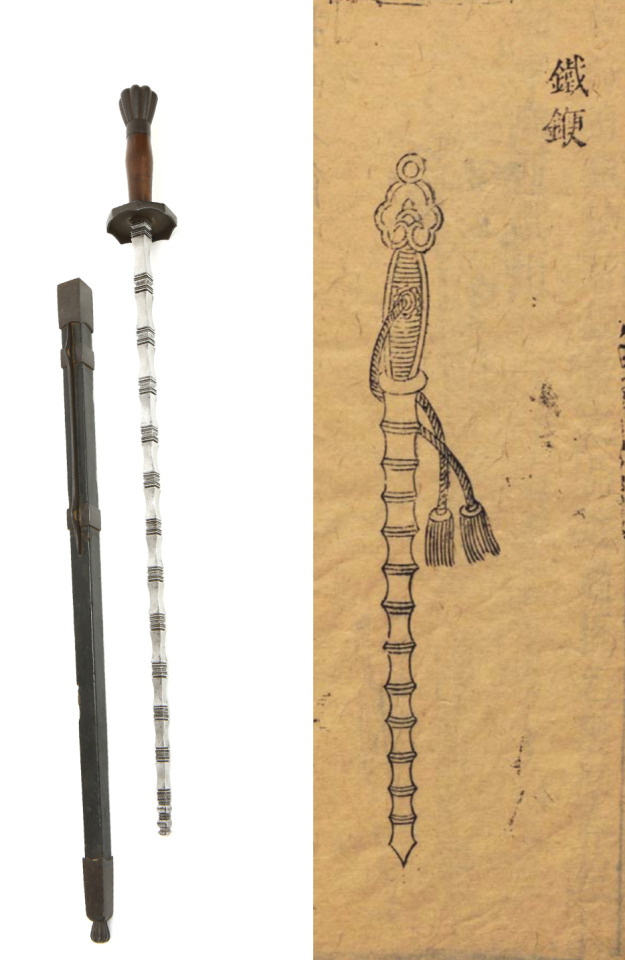


Kumoi[久面井] Entetsu[煙鐵]
Ku[久]: "A long time"
Mo[面]: "Face/Mask/Surface"
I[井]: "Well(water source/hole in the ground)"
En'[煙]: "Smoke"
Tetsu[鐵]: "Iron"
He sounds and looks very much like a jailer/torturer, not unlike some vibes Urahara's backstory gave off. Kumoi's zanpakuou is also a Tiěbiān[鐵鞭], a sectioned iron rod, part of a broader family of weapons/tools all called "iron whips."
Interestingly it's the same type of weapon Sui-feng's bankai, Jakuhou Raikouben[雀蜂雷公鞭], is named after.
Outokawa[王途川] Furuoki[雨緒紀]
Ou[王]: "King"
To[途]: "Road/Way"
Kawa[川]: "River"
Furu[雨]: "Rain"
O[緒]: "Cord/String(of an instrument)"
Ki[紀]: "Era/Period(of time)" or "Rule/(Written)Record"
"King's Way River" is a very pompous sounding family name... Interestingly the name Furuoki uses the kanji [雨] for rain, but is pronounced here like furu[降る] which is the verb for "to fall" referring specifically to rain or snow. The "Era of Rain(fall) String." It might be a stretch but I want to interpret that as the lines of rain falling being equated to the string of an instrument, and by proxy comparing the sound of rain fall as music.
But alternatively it could be another play into Kubo's on-again-off-again rain symbolism. Sometimes it's Ichigo's depression, sometimes it's Uryuu's legacy as the last Quincy, sometimes it's Orihime making confusing statements about joining earth and heaven, in direct contradiction to her Tanabata namesake... Is it "The Rule of Rainfall" as in the downpour comes eventually no matter how you run from it? Or as in, heaven and earth are joined eventually if your just wait? Or as in heavens will be clouded over and separated eventually? Or as in, relief comes eventually and even the worst drought can't last forever?
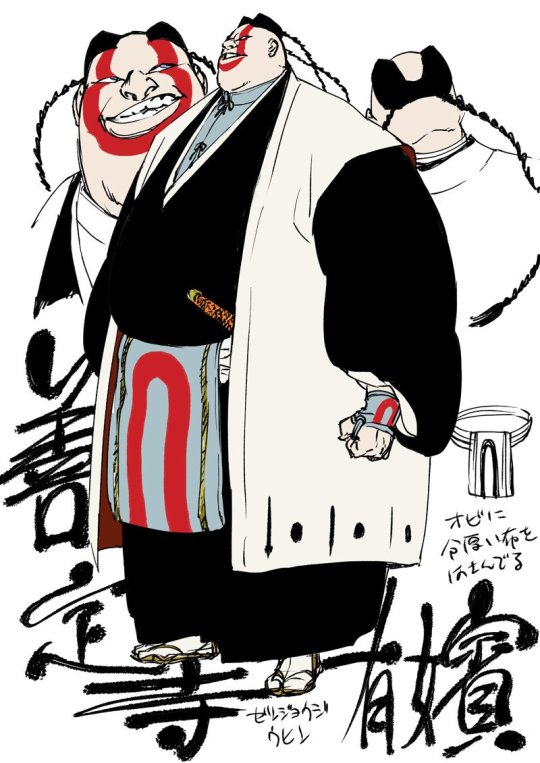
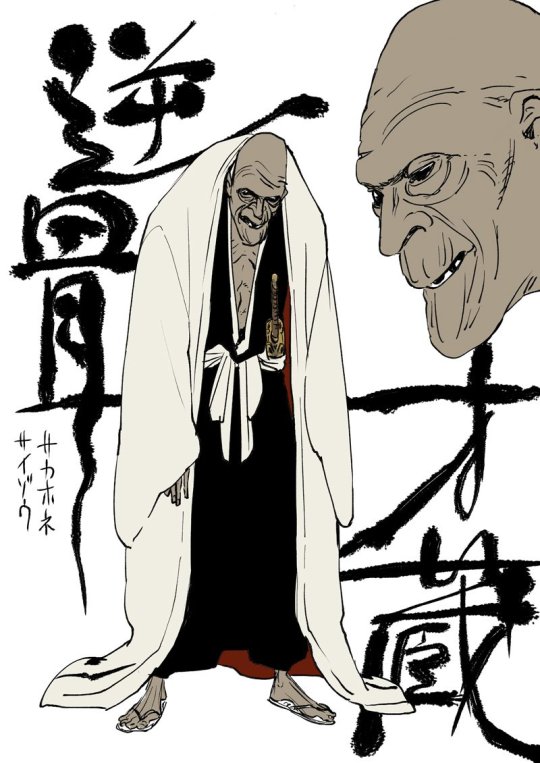

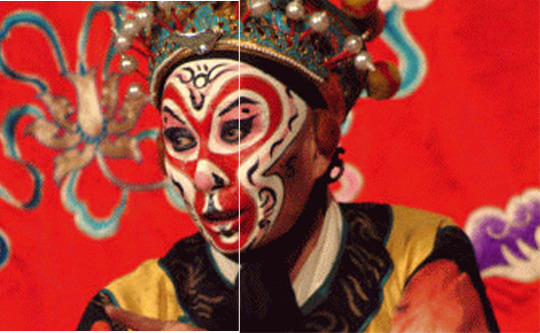
Zenjouji[善定寺] Uhin[有嬪]
Zen'[善]:"Virtue/Goodness/Good deeds
Jou[定]: "certainty/reality/samadhi"
Ji[寺]: "temple"
U[有]: "bhava/becoming/existence"
Hin'[嬪]: "court lady/virtuous woman/concubine"
So I can't quite tell if Kubo's just leaning into the on'yomi here, or if he's specifically aiming for a Chinese reading. I want to say On'yomi, but it is fairly close to the Chinese reading Shàndìngsìyǒ[善定寺] upín[有嬪] it's just the dìng[定] vs jou[定] throwing a wrench in it. And I'm hung up on Jiuhin's name sounding Chinese because with the mandarin style collared shirt and the fact that he has... for some reason two... queue... it all points to a distinctly Chinese influence in the design.
Arguably the face paint could also be pulled erroneously from the broader aesthetic of Chinese opera --as in maybe Kubo was going for a Chinese opera inspired look, but what's here definitely isn't accurate to the style-- but it feels very in line with Kubo's own funky sensibilities either way.
Sakahone[逆骨] Saizou[才藏]
Saka[逆]: "Reverse"
Hone[骨]: "Bone"
Sai[才]:"Talent/Ability"
Zou[藏]: "Hidden"
....the idea that this decrepit old man is named "Reverse Bones" as if he's like that because his bones are just "wrong" is for some reason hilarious and horrifying to me. "Hidden Talent" seems self-explanatory given he looks like he should barely be able to move, let alone fight or kill a person.
#bleach#shinigami#gotei 13#not tagging all those#just wanted to give thees all a quick once over while it was slow at work#didn't think too hard about them honestly#but given there's literally no content to cross reference...#I don't know that there's anything i'd have added given more time#mostly just played fast and loose with the visual assocaitions#as ever im really just looking at kanji choice#and not digging around for homonyms and puns all that much
201 notes
·
View notes
Text
[ 📹 Footage from strikes launched by U.S. Forces targeting IRGC-backed militias in Iraq and Syria. The Syrian Ministry of Defense reported the deaths of several civilians and military personnel as a result of the strikes.]
🇮🇷⚔️🇺🇸 🚀💥 🚨
IRAN FOREIGN MINISTRY SPOKESPERSON SLAMS US STRIKES ON IRGC TARGETS IN IRAQ AND SYRIA
The Iranian authorities condemned a series of air and missile strikes launched by U.S. forces Friday targeting several Islamic Revolutionary Guard Corps (IRGC) sites inside Syria, where Iranian Quds Forces assist and train the Syrian Arab Army and local militias to guard against attacks by radical jihadist groups supported by the United States.
Iran's Foreign Ministry spokesperson, Nasser Kana'an, slammed Friday's U.S. strikes on targets in Iraq and Syria, declaring the move an "adventurous act" and a "strategic mistake," and calling it a "violation of the territorial integrity and sovereignty of Iraq and Syria, as well as international law, and a blatant breach of the UN Charter," according to a press release published by Iran's Foreign Ministry.
Condemning the U.S. strikes and tying it together with Israel's ongoing war of genocide in the Gaza Strip, Kana'an added, “Not to mention the United States’ all-out support for 4 months of relentless and brutal attacks by the Zionist regime against residents of Gaza and the West Bank as well as military strikes against Yemen and the violation of this country’s territorial integrity and sovereignty, last night’s attack on Syria and Iraq was yet another adventurous move and strategic mistake by the U.S. government, which will have no result other than the escalation of tensions and instability in the region."
According to the Foreign Ministry, the United States's attacks on Iraq, Syria and Yemen are designed to secure the interests of the Zionist regime of the Israeli entity, with Kana'an warning that “Such strikes embroil the U.S. government in the region more than ever before and overshadow the Zionist regime’s crimes in Gaza."
Concerned with the dangers of a regional war, the Foreign Ministry spokesperson exhorted the dangers of such strikes, which he said could pose a threat to regional and international peace and security.
Kana'an emphasized the responsibility of the international community and the role played by the United Nations Security Council in preventing "illegal and unilateral" strikes by the United States.
“As the Islamic Republic of Iran has announced time and time again, tensions and crises in the region are rooted in the Israeli regime’s occupation and perpetuation of this regime’s military operations in Gaza and the genocide against Palestinians with unlimited support from the United States, and that stability and security cannot be restored to the region without focusing on the root cause of the crisis and its settlement," Kana'an warned.
#source
#videosource
@WorkerSolidarityNews
#iran#iran news#iran foreign ministry#iranian news#middle east#war#war news#united states#us military#us armed forces#united states armed forces#us news#us politics#us wars#us imperialism#us foreign policy#politics#news#geopolitics#world news#global news#international news#palestine#israel#gaza#breaking news#current events#arab israeli conflict#irgc#islamic revolutionary guard corps
9 notes
·
View notes
Text
Comatose
A multi-chapter fic inspired by the Sandman and its characters
Pairing: Dark!Vigilante!Morpheus x You/Reader
Basically, a detective human AU self-indulgent enemies to lovers fic
Premise:
The man who called himself the King of Nightmares watched as the lowlife before him, bound and drugged, writhed and screamed of horrors only he could see, the potent poison - his brand - working to turn the mind against itself: it was music to his ears like no other. The man before him would eventually fall into a state of perpetual terror until his ultimate demise, as was his design. This was his own brand of justice, and only those who escaped the hand of the law, the ones he deemed unworthy of life, were doomed to meet it.
But, then, there was you: you, a rookie detective with your unorthodox methods, a survivor of harrowing trauma, the only angel in among the horde of demons who dare call themselves officers of the law. You had dared challenge him to a dance, a battle of wits, and promised to put an end to his nightmarish reign. The moment you had come closer than anyone else had to finally catching him, he was simply enamoured, and from that day forth, he made a vow of his own:
That he’ll get to you first, his precious little angel; he’ll clip your wings and keep you in a cage so you can be his. The world, after all, does not deserve you.
Status: Not yet written
Release date: After I finish my ongoing fic
Warnings: DARK, murder-y, and stuff
Other warnings to follow
Stay tuned for more updates!!!
Special thanks to @ambercoloredfox!!
#dark!morpheus fic#dark!morpheus fanfic#dark!human!vigilante!morpheus fic#dark!morpheus x reader#dark!dream x you#dark!morpheus x you#incoming dark!morpheus fic#dotieeeee writes!!#enemies to lovers fic#self-indulgent fic
60 notes
·
View notes
Note
You can't be racist to white people the same way. You can be racist to black people. That's not how racism works. I randomly found your profile as I was looking through reblogs on fan art. You aren't going to have fewer opportunities and be treated unfairly for solely being white.
Systemic racism is different from racism. Racism against any race is the exact same shit. I literally have a link to a dictionary in my about section. In fact here's the definition of racism and slur.
the belief that different races possess distinct characteristics, abilities, or qualities, especially so as to distinguish them as inferior or superior to one another.
an insulting or disparaging remark or innuendo :
Saying you can't be racist to white people like you can black people is inherently racist as all fuck. I literally have multiple reblogs showing people casually saying racial slurs (the fact multiple people categorically say you can't be racist to white people shows an inherent worldview where white people are inferior to all other races since they lack the ability to experience racism) to me assuming I'm white lmao. Cracker is absolutely a racial slur and I've linked why multiple times too.
"The following is a list of ethnic slurs, ethnophaulisms, or ethnic epithets that are, or have been, used as insinuations or allegations about members of a given ethnicity or racial group or to refer to them in a derogatory, pejorative, or otherwise insulting manner. .... For the purposes of this list, an ethnic slur is a term designed to insult others on the basis of race, ethnicity, or nationality."
Please read a dictionary and focus on something that actually matters currently instead of this ridiculous claim that goes directly against the definition of racism.
No ism excludes a particular demographic, otherwise it'd literally be the thing it's defining.
There are literally multiple ongoing genocides halo currently, focus on that or global warming instead of trying to tell me the definition of racism when I've literally quoted it multiple times.
This misery Olympics shit is tiresome and gets society nowhere. All racism is equally bad and fucking stupid as sin. Stop perpetuating a problem.
11 notes
·
View notes
Text
Business Development in a Competitive Market: Strategies to Stay Ahead

In today's dynamic business landscape, thriving amidst fierce competition necessitates a strategic roadmap fueled by innovation, strategic thinking, and decisive action. This comprehensive guide serves as your compass, unveiling an array of meticulously tailored strategies designed not just to help you navigate the complexities but also to position your business as a torchbearer in a competitive market.
DOWNLOAD THE INFOGRAPHIC HERE
1. Understand Your Unique Value Proposition
In a world brimming with choices, establishing a distinct identity is paramount. This section delves into the intricacies of B2B Database Leads and B2B Lead Generation, unraveling the process of crafting a Unique Value Proposition (UVP) that resonates. By pinpointing your unique strengths and communicating them effectively, you forge a connection with your target audience that goes beyond transactional engagement.
2. Leverage Data Analysis
In an era where data is the cornerstone of decision-making, interpreting insights is a competitive advantage. Exploring Sales Leads and B2B Sales trends, this segment underscores the power of data analysis. By deciphering patterns, uncovering market shifts, and discerning consumer behaviors, you empower your business with the foresight needed to pivot proactively and capture emerging opportunities.
3. Prioritize Customer Satisfaction
Loyalty isn't just earned; it's cultivated through exceptional experiences. This part immerses you in the world of Sales Prospecting and B2B Database Leads, emphasizing the role of customer satisfaction. By anticipating needs, delivering prompt resolutions, and personalizing interactions, you foster a base of loyal customers who not only return but also advocate for your brand.
4. Invest in Technology
Technology isn't an accessory; it's the engine driving modern business. This chapter, interweaving Business Development and Sales Funnel strategies, magnifies the impact of technology investments. From streamlining operations to enhancing customer engagement, technological innovation is the catalyst for improved efficiency, customer delight, and strategic growth.
5. Engage in Strategic Partnerships
Collaboration isn't just a concept; it's a gateway to exponential progress. Venturing into B2B Lead Generation and AccountSend strategies, this section illuminates the art of forming strategic partnerships. By aligning with entities that complement your strengths and expand your reach, you embark on a journey of shared growth, propelling each other toward collective success.
6. Nurture a Strong Company Culture
Company culture isn't just for the office; it extends to every customer interaction. This segment dives into the subtleties of Sales Prospecting and B2B Database Leads, highlighting the significance of a robust company culture. A culture that champions innovation, values diversity, and empowers employees becomes the secret ingredient to attracting top talent and fostering exceptional customer experiences.
youtube
7. Adopt Agile Business Practices
Agility isn't just a buzzword; it's a competitive necessity. This part immerses you in the core of Business Development and B2B Sales, emphasizing the power of adaptability. By embracing flexible strategies, swift course corrections, and rapid responses to market shifts, you ensure your business remains poised to seize opportunities, even in the face of uncertainty.
8. Innovate Constantly
Innovation isn't sporadic; it's a perpetual journey. Navigating Sales Funnel dynamics and B2B Sales strategies, this section spotlights the importance of ongoing innovation. Whether through breakthrough products, iterative improvements, or ingenious solutions to challenges, a commitment to innovation becomes the lifeblood of your brand's growth and resilience.
9. Enhance Your Online Presence
In the digital realm, your online presence is your storefront. This part delves into Sales Prospecting and B2B Database Leads, emphasizing the role of a robust online presence. From an engaging website to active social media engagement, your digital footprint becomes the canvas on which you engage, educate, and forge connections with your audience.
10. Invest in Continuous Learning and Development
In a landscape where change is constant, learning is your compass. This final chapter, rooted in Business Development and Sales Leads, underscores the value of continuous growth. By fostering a culture of learning, you equip yourself and your team with the tools needed to decipher trends, refine strategies, and navigate the evolving landscape with confidence.
In the intricate tapestry of business, thriving is more than an aspiration; it's a science that marries B2B Lead Generation, Sales Prospecting, and Business Development. This guide empowers you to take the reins, lead with insight, and emerge as a frontrunner in the competitive race, armed with strategic prowess, innovative spirit, and an unwavering commitment to progress.
#AccountSend#B2BLeadGeneration#B2B#LeadGeneration#B2BSales#SalesLeads#B2BDatabases#BusinessDevelopment#SalesFunnel#SalesProspecting#BusinessOwner#Youtube
16 notes
·
View notes
Text
Israel votes to label UN agency terror organisation
The Israeli parliament on Monday tentatively approved a bill declaring the UN aid agency for Palestinian refugees a terrorist organisation, The Independent reports.
The bill, authored by Israeli politician Yulia Malinovsky, accuses the UN Relief and Works Agency (UNRWA) of acting as a “fifth column inside Israel.” The bill alleges that many UNRWA employees are members of terrorist groups such as Hamas and Islamic Jihad, although no evidence has been provided.
UNRWA, which provides essential services to millions of Palestinians, has faced growing opposition from Israel, which has called for its dissolution.
The vote marks a significant escalation in Israel’s efforts to dismantle the agency, despite international opposition and the resumption of funding by some donor countries following a surprise Hamas attack on October 7 that triggered the ongoing war in Gaza. UNRWA suspended 12 staff accused of involvement in the attack.
Both Hamas and the Palestinian Authority condemned Monday’s vote, as did several countries, including Jordan. Jordan’s Foreign Ministry said Monday that the Israeli move was “an attempt to kill the agency, defeat it politically and strike at its symbolism, which affirms the right of return and compensation for Palestinian refugees under international law.”
UNRWA spokesperson Juliette Touma called the law “another attempt in a wider campaign to dismantle the agency”. She also added:
“Such steps are unheard of in the history of the United Nations.”
When the bill was first proposed earlier in May the EU, the largest donor to UNRWA alongside its member states, highlighted the agency’s “crucial and irreplaceable” role in addressing the humanitarian crisis in Gaza. Josep Borrell, the bloc’s foreign policy chief, said in a statement at the time:
“The European Union is deeply concerned about discussions in the Israeli Knesset on designating UNRWA as a terrorist organisation, and removing its staff’s immunities and privileges. The EU is a strong supporter to the agency, and remains, with its member states, its biggest donor.”
Belgium, an EU member, also issued its own criticism of the bill. Belgium’s foreign minister Hajda Lahbib wrote on X:
“Belgium condemns the Israeli parliament’s attempts to classify UNRWA as a terrorist organisation and to remove the immunity of its staff.”
And also speaking out over the matter in June, Saudi Arabia condemned the bill saying UNRWA employees “are doing their duty to alleviate the severity of the humanitarian catastrophe that the Palestinian people are going through.” The Saudi foreign ministry had said at the time:
“The kingdom stresses that Israel, as an occupying state, must abide by international law and international humanitarian law and stop obstructing the work of international organisations.”
Qatar’s foreign ministry had also said the attempt to brand UNRWA a terrorist organisation was “an extension of the systematic campaign aimed at dismantling the agency at a time when the need for its humanitarian services is dire due to the ongoing war in the Gaza Strip.” Christopher Lockyear, secretary general of MSF International, said:
“By branding the UN agency created to aid Palestinian refugees as a terrorist entity, Israeli authorities would be perpetuating a narrative that vilifies and marginalises an entire population and those who provide them with assistance.”
UNRWA’s 30,000 staff provide education, primary health care and other development activities for some six million Palestinian refugees in Gaza, the West Bank, Jordan, Lebanon and Syria.
Sixteen countries cut off about $450 million in funding to UNRWA after Israel accused 12 of the agency’s 13,000 workers in Gaza of involvement in the October 7 attack on southern Israel.
UNRWA chief Philip Lazzarini said at the time that he was “shocked” by Western countries’ decisions to cut off aid funding as “famine” loomed over the people of Gaza amid the ongoing war between Israel and Hamas.
Read more HERE

#world news#news#world politics#middle east#middle east crisis#middle east war#middle east conflict#middle east news#israel#israel palestine conflict#israel palestine war#israel politics#gaza strip#gazaunderattack#gaza#palestine#un#united nations#israel hamas war#hamas#hostages
2 notes
·
View notes
Text
KE AUPUNI UPDATE - MAY 2024

Hawaiʻi’s Lands…
Hawaiʻi’s monarchs understood international law. Which is why Kamehameha III saw that the way to protect his Kingdom’s sovereignty was to be recognized as a sovereign country. This was accomplished in 1843 when two of the most powerful colonizer nations in the world, Great Britain and France recognized the Hawaiian Kingdom as a sovereign state.
Even with that in place, just in case… King Kamehameha III wanted to further safeguard the lands of the Kingdom from foreign take-over. As the Monarch, he was not only the ruler, he “owned” all the lands of the Hawaiian Kingdom. But he realized that in the event Hawaiʻi got conquered by another country (or an internal regime change) the monarch’s lands, i.e. government lands, would be susceptible to takeover by conquest.
Under international law, the lands owned by the government would become the lands of the conqueror as spoils of war. But, privately owned lands would remain in the hands of the private owner. Aha!
Learning of this, King Kamehameha III initiated the Great Mahele, the major land redistribution, to move the vast majority of Hawaii’s land out of harm’s way. He converted most of the monarchial/government lands of Hawaii into private ownership, leaving only those lands necessary for government operations as government lands.
Private titles to lands were given to chiefs and commoners, with the largest portion to the King. Furthermore, much of the lands came with allodial titles to ensure these private lands would only be passed down to the person’s designated heirs, in totality and in perpetuity. These lands could not ever be sold or alienated from the heirs.
Unfortunately, when the puppet governments of the US took over in 1893, they began to help themselves to Hawaiian lands, carving them up and selling off pieces in complete disregard for Hawaiian Kingdom laws and international laws concerning private land titles.
It got worse over the years. Using their crooked judges, the US occupation and its local business and political collaborators wantonly plundered the lands of the Hawaiian people — even the allodial-titled lands of heirs of Kamehameha III and other Aliʻi (chiefs) — by ignoring the continuity and inviolability of private, allodial-titled lands.
The land fraud in Hawaiʻi is massive, pervasive and ongoing. Deprived of their inheritance, Hawaiians have been impoverished and driven off the islands by greedy foreigners, their corrupt judges and US puppet governments.
The good news is that is about to change. Along with the campaign to rescind UNGA Resolution 1469 at the UN, questions about the Lāhainā fire, Hawaiians who have been injured by these ongoing land thefts have been raising international challenges and seeking remedy for those abuses.
“Love of country is deep-seated in the breast of every Hawaiian, whatever his station.” — Queen Liliʻuokalani
----------
Ua mau ke ea o ka ʻāina i ka pono. The sovereignty of the land is perpetuated in righteousness.
------
For the latest news and developments about our progress at the United Nations in both New York and Geneva, tune in to Free Hawaii News at 6 PM the first Friday of each month on ʻŌlelo Television, Channel 53.
------
"And remember, for the latest updates and information about the Hawaiian Kingdom check out the twice-a-month Ke Aupuni Updates published online on Facebook and other social media."
PLEASE KŌKUA…
Your kōkua, large or small, is vital to this effort...
To contribute, go to:
• GoFundMe – CAMPAIGN TO FREE HAWAII
• PayPal – use account email: [email protected]
• Other – To contribute in other ways (airline miles, travel vouchers, volunteer services, etc...) email us at: [email protected]
All proceeds are used to help the cause. MAHALO!
Malama Pono,
Leon Siu
Hawaiian National
2 notes
·
View notes
Note
Annon-Guy: What do you think of the characters from Dawn of the New World?
Emil Castagnier, Ratatosk, Marta Lualdi, Tenebrae, Richter Abend, Aqua, Alice and Decus.
like I said before I only know these characters from Tales of the Rays so this will be my impression from how they are depicted in Tales of the Rays
Emil: He’s a nervous wreck who is doing his best to get along with his alter. He’s got the lofty position of actually getting with the female protagonist in an actual ongoing relationship which means he somehow has more game than like 80% of the other characters. I like his design, his scarf is cute.
Ratatosk: perpetually angry man named after Ratatoskr, the squirrel that runs up and down Yggdrasil to carry messages. However, I saw no evidence from what I’ve seen of him in Rays that he was ever a messenger boy. I did think his scene with Asch in the Asch & Natalia event was hysterical though.
Marta: She kind of seems like a very pushy airhead. Presumably wears the pants in her relationship with Emil? Idk she seems to be dating BOTH Emil and Ratatosk in Rays and I approve. I like her design a lot too her flowers are very cute. She can join Natalia, Arche, and Raine in the “I can’t cook support group”
Tenebrae: Ok to be honest I haven’t seen anything with him outside of Dhaos’s first skit and all he rlly did was talk about Mana and the Aesthetic of Darkness so I have no idea what’s up with him. It was sweet that he offered to listen to Dhaos’s woes but predictably Dhaos refused. I also think his design is neat.
Richter: He’s the guy who is pissed bc Ratatosk murdered his bestie and stole his body right? He’s working for the bad guys in Rays cuz they’re using Aster as leverage against him… I haven’t seen him interact much with Emil or Marta, but I like his vibes with the other characters. He seems like he’s trying to make the best of an awful situation :( also he’s a megane character so ofc I like him :)
Aqua: idk who this is. I don’t think they’re in Rays. Sorry 😔
Alice: I haven’t seen much of her but I know she broke into Sync’s room to try to meet up with Mithos bc she knew he followed Sync around. So that’s funny. Otherwise, I think she’s mostly just sadistic. She’s also a half-elf so she’s presumably got some tragic stuff going on.
Decus: All I know about this man is that he’s a simp for Alice. Literally.
5 notes
·
View notes
Text
Animation Night 143 - Lupin III
Animation Night oldtimers - what few remain... - may remember Animation Night 37. It was a fun night where we carved a core through the Lupin III franchise in its many iterations.
For a series of such towering importance to the history of anime, I must have written a massive writeup, right? Ah, if only ‘twere so. Apparently I was having meds trouble - la plus change... - so all you got was a list of films and a promise to write more later.
Well, it’s finally time! Fully two years later x3
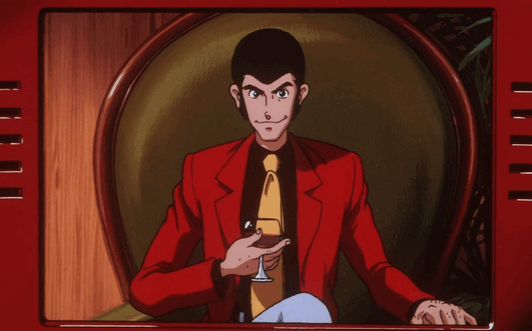
So, Lupin III! It’s a lot of things but before it was any of them, it was a gritty seinen manga by Kazuhiko Katō - far better known by the name Monkey Punch - serialised in a magazine called Weekly Manga Action starting in 1967. Here’s the opening spread...
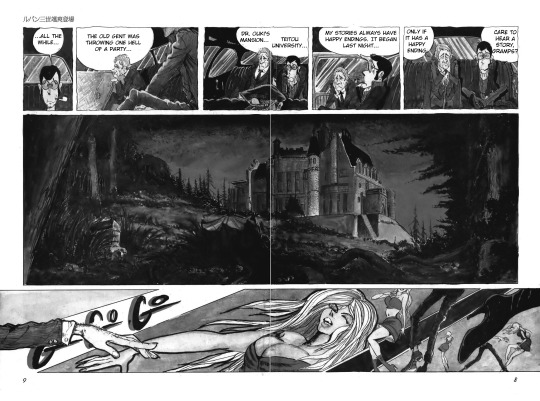
At this time, Monkey Punch was 30, meaning he’d grown up through the second world war, starting his career in comics in junior high where he competed with other artists in the school newspaper. His route into manga was via dōshinshi, then 4koma, and eventually working as an assistant to Naoki Tsuji on influential wrestling series Tiger Mask.
Lupin III took inspiration from, of course, Maurice Leblanc’s stories of gentleman thief Arsène Lupin, by way of a little James Bond. Many of the details of the plot were improvised. Femme fatale Fujiko Mine was originally to be one of a rotating cast of girls like in the Bond films, but that proved to be too much work, so she became a recurring character. Lupin’s samurai buddy Goemon was originally his enemy.
The Lupin manga has that strange horny energy that you tend to expect from 60s manga. It’s definitely still a comedy, but the kind of comedy where the first issue involves microfilm hid inside someone’s vagina and the second has a man almost wrongfully executed. The artwork is sometimes very detaile, but more often sketchy; its expressions are exaggerated, but it predates the codification of standard manga expressions. It’s shaded - in watercolours, I think, and markers. It feels very different from later manga characterised by ultra-precise illustration.
At this point in the history of manga, the waves of gekiga were beginning to be felt. So far as I’m able to tell the distinction goes, Lupin falls outside the (later-defined) line between ‘gekiga’ and ‘manga’, but there was definitely a feeling that more ‘serious’, dramatic stories were coming in. Original flavour Lupin is less ‘thief with a heart of gold’ and more ‘horny trickster’, a much more amoral character.
The manga introduces at first the cat-and-mouse pair of Lupin and Inspector Zenigata, perpetually a step behind. It gradually introduces the rest of the recurring characters: rival thief Fujiko the sexy girl full of cunning plans; Lupin’s partner the gunslinger Jigen whose main trait is shooting really fast and accurate; samurai Goemon whose sword can cut anything, especially clothes.

So, the anime then! This is one of those nights where we’re leaning on Matteo Watzky, who’s provided a great deal of information on the production of the original Lupin TV series.
Lupin was only in serialisation for a year when esteemed animator Yasuo Otsuka left Toei in the midst of ongoing union struggles, shortly after the completion of Horus: Prince of the Sun on which he’d worked as animation director. (See Animation Night 70 for more on that!) Otsuka landed at A-Pro, one of a number of studios in the orbit of a company called Tokyo Movie Shinsha, to work on an adaptation of Lupin - at the time, intended to be a feature film under the direction of Masaaki Osumi.
In 1969 they finished a twelve-minute pilot film that steered close to manga in both design and sensibility. Monkey Punch himself provided some supervision. The pilot is a series of brief vignettes introducing the main characters of the manga, with a narrator describing their main traits and fashion choices before brief skits that mostly end in explosions. Its animation is impressively elaborate and stylish and does not look like much from the era, but producers balked at all the sex and violence, so it was retooled into a TV show. Otsuka and Osumi were pulled away to work on Moomin, and the staff shuffled around a lot - not for the last time.

Lupin finally hit TV in 1971, again under Osumi with Otsuka designing characters. It was going for something dark and dramatic by the standards of the time, in the vein of Ashita no Joe (c.f. Animation Night 95) or Star of the Giants. But Osumi’s manga-faithful take hit poor ratings, and when Osumi was unwilling to compromise, he was gradually squeezed off the project.
Instead, Otsuka brought in two of his protégés from the Toei days, recently hot off the collapse of Pippi Longstocking. You may have heard of them. They were of course Hayao Miyazaki and Isao Takahata - at this point an inseparable pair. Although they took over the series, they did a lot of it pseudonymously, and they would leave A-Pro down the line.
The series that resulted under their direction is known to fans as ‘Green Jacket’ Lupin, because (shockingly) Lupin wears a green jacket. It’s full of foreshadowing for Miyazaki’s later works. Osamu Dezaki, also working pseudonymously, directed a number of episodes as well in his distinctive style. Under their direction, the series became a lot lighter in tone, with a gleeful sense of chaos that would become the defining tone of later adaptations. It wrapped up after 23 episodes, with Miyazaki apologising for the stuff - but all in all it was a success, although not as much as the next one would be...
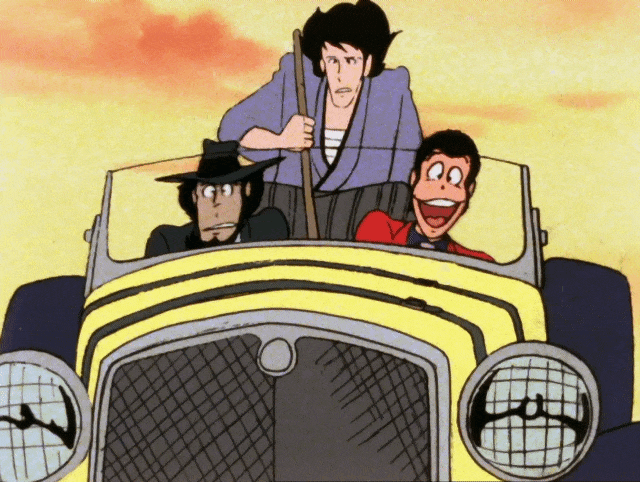
The second Lupin III adaptation, Lupin III Part II known as ‘Red Jacket’ Lupin, came six years later. In this time a great deal had happened. A-Pro had evolved into Shin-Ei and left the TMS orbit, and the other TMS satellites like Madhouse were also going their own way; in such uncertain conditions, and with their own director obsessed with his ultimately fruitless project to adapt Little Nemo In Slumberland, TMS sought to return to some of their various established licenses to make some reliable money.
A very long production that hit 155 episodes, the Red Jacket series is where Lupin really took off. It’s a mixed bag, with plenty of filler, but also several real standout scenes and episodes. In Watzky’s account, much of this has to do with the involvement of Oh Production, a subcontracting studio that would be a close ally of Takahata and Miyazaki right into the Ghibli days. Their star was Kazuhide Tomonaga, known for his work on Space Battleship Yamato, not to mention duelling Yoshinori Kanada to outdo each other in effects for the ridiculously elaborate finale of Galaxy Express 999. Tomonoga’s best moments would come after Miyazaki’s return, but we’ll come to that in a moment.
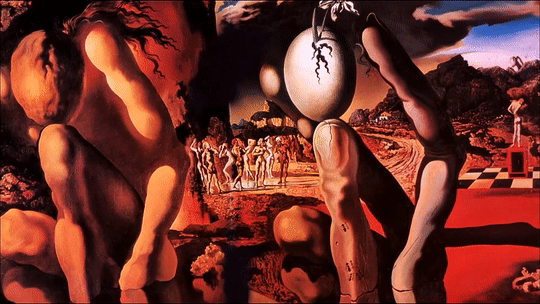
Red Jacket gave rise to the first Lupin movie, The Mystery of Mamo, which served as a vehicle to bring back a lot of the departed Shin-Ei animators into the TMS fold, and prior to Akira, it was the highest budget animated film in Japan with enormous ambitions for animation. Read Matteo’s article to get a sense of the different animators and studios shuffling around, but to summarise very briefly, it brought back most of the staff who had created the pilot film and they were able to bring much of the same energy. The film sets Lupin up against an immortal psychic billionaire, and it features an impressively varied animation style, with manga panels or a dreamlike psychic sequence when Lupin runs through a series of series of surrealist paintings.
Next came... guess what... The Castle of Cagliostro! Miyazaki’s back and he’s going to push his vision of Lupin as a romantic, kind-hearted character to a new level, once again in a green jacket. The film featured startlingly elaborate animation. The car chases cemented Lupin’s car as a staple of the series, the finale features the classic ‘I am a traditional animator and I want to flex’ setting of a gigantic clock full of cogwheels. It’s as fun and impressively shot a film as you’d expect from something headed by Miyazaki, although to Lupin fans, it is widely seen as a frustrating one, since it hews furthest from the ‘proper’ roguish characterisation of Lupin.

Cagliostro is also important for another reason: among otaku, the nascent lolicon movement fixated on its character Clarisse, much as Miyazaki himself had once fixated on the girl Bai-Niang from Toei’s The White Snake Enchantress. That’s a... complicated subject to explicate to put it mildly; I discussed it more on Animation Night 69. ‘Clarisse clones’ started popping up all over the place; Cagliostro was perfectly placed as one of the most impressive animated movies at the dawn of the otaku boom.
The TV series continued to run throughout all this, and the success of Cagliostro washed back in, with sudden character redesigns and of course, the two episodes directed by Miyazaki exhibiting all his quirks. Its scenes feel eerily preminiscent of Ghibli, even more so than Green Jacket, elaborate enough to seriously push the envelope on TV animation.
After all this, Lupin had been firmly cemented as a ‘classic’, nostalgic series in anime. Rather than a single canonical story, it was a group of iconic characters with a general setting and tone that was flexible enough to accommodate many more stories. This probably has a lot to do with its enduring presence: you certainly don’t have to have followed Lupin III from the very beginning to be able to jump in to one of the later installments and have a pretty good sense of what’s going on. There is a comfortable status quo, with Zenigata chasing Lupin who’s always one step ahead; from there, you can pull Lupin and the gang into whatever escapade you have in mind.
Through the 80s and 90s, TMS continued to produce Lupin films with a variety of directors. These generally follow the tone set out by the TV series and they’re a lot of fun. Monkey Punch himself actually directed one, being Lupin III: Dead or Alive, albeit reluctantly at the last minute! The 2000s saw TMS, facing budget limits, stripping production down to OVAs.

The most interesting change of direction came with Sayo Yamamoto, of Michiko and Hatchin and later, Yuri on Ice, who we covered back on Animation Night 36. Reading back her comments in the present, it’s like, wait, that Mari Okada?
In Yamamoto’s hands, the focus shifted from Lupin (though he’s still present) to Fujiko as the main character. The tone hews far closer to Monkey Punch’s manga: sex and violence, sure, but also escapades. It’s a hell of a ride, with all sorts of unexpected tones.
The animation, although clearly taking inspiration from the heavy lines of the manga, is most of all a Koike-ism - the deliberate and weighty way characters move, the use of black, the colour palette all scream ‘I just finished working on Redline for seven years’. Koike would end up staying with Lupin even after Yamamoto moved on, directing a trilogy of hour-long movies, Jigen’s Gravestone, Goemon’s Blood Spray and Fujiko’s Lie.
Last time we did Lupin, we watched one of the three, Goemon’s Blood Spray, last time, and honestly... well it’s a weird one! If Yamamoto’s take was able to preserve the comic chaos even with the darker content, Koike decided to fully go for a drama, with a very strange plot that sees Goemon going on a kind of spirit quest as he’s drawn into an intense battle with first gangsters and then a massive lumberjack guy. The long final battle of the movie sees the two gradually slicing bits off each other, meticulously animated in the way only Koike can (truly I never have seen a more carefully rendered sagittal section of the upper arm muscles), but at the time I found the film struggles to deliver the emotional stakes. It’s a long way from the rest of Lupin, and I’m curious but a little apprehensive to see what Koike did with the other two films.
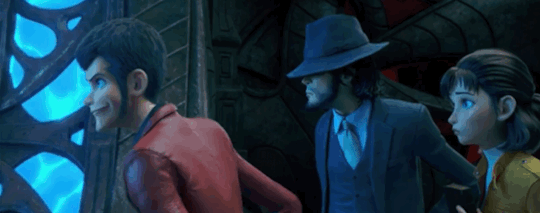
The other major development in Lupin films is the CG film Lupin III: The First (2019) dir. Takashi Yamazaki (his first animated film), featuring a distinctive stylisation that reminds me most of recent Chinese films like New Gods: Nezha Reborn. It’s a curiously bold departure; it caught my attention with clips of hyperchoreographed action scenes; it’s got a very broad, exaggerated style of movement that’s far from the norm for anime and a constantly roving camera. It’s kind of fascinating to look at, CG that isn’t trying to look like something else. It’s also a departure for the animators at Marza Animation Planet, whose previous works tended to be hyperrealist adaptations such as the 2013 version of Space Pirate Captain Harlock or Kingsglaive: Final Fantasy XV. That’s a lead to follow up on, actually. They would later come to work on the Sonic the Hedgehog films.
So, this movie. It’s evidently attempting to retool Lupin for the CG era, with tributes to the iconography of the old anime, such as remaking Lupin’s car in 3D and staging a chase with it; whether this attempt to ‘modernise’ will land I’m not sure. I don’t love their models for the female characters especially lol, they’re painfully Disney. The plot is a Lupin escapade vehicle with a dash of Indiana Jones, putting Lupin and the gang up against Nazi occultists. I don’t expect it to challenge much, but it does look fun.
So! What’s the plan for tonight?
Well, it’s basically the same plan as last time: another cross-section through the Lupin III series! We’ll hit the following notes:
the original Lupin pilot!
The Mystery of Mamo
Miyazaki’s two episodes of Lupin III Part 2!
the two parts of Jigen’s Gravestone
Lupin III: The First
Sound fun? Great! (Doesn’t sound fun? I’ll shoot you.) We’ll be starting early tonight; going live at 7pm UK time, and starting films after about 20 minutes. I’m going to try and keep the start of Animation Night in the 7-8pm range from now on - let’s see if we can rebuild this thing.
If you will, then: head to https://twitch.tv/canmom and get ready for some burglary, robbery, theft, and even perhaps a bit of larceny. See you in the theatre~
20 notes
·
View notes
Text
Getting Started with Full-Stack Web Development: Obstacles and Opportunities
Embarking on the journey to becoming a full-stack web developer offers a blend of exhilarating challenges and rewarding accomplishments. In this guide, we'll explore the intricacies of mastering full-stack development, delving into the obstacles you may face along the way and the triumphs that await those who persevere.
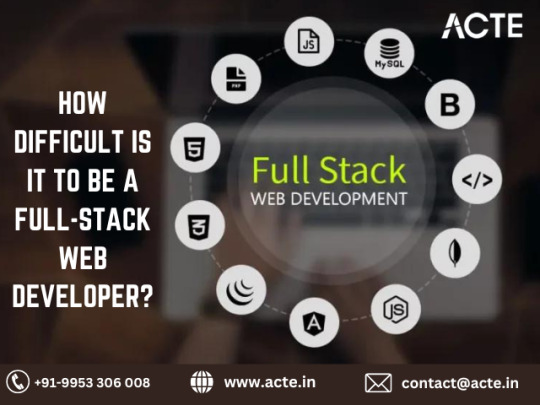
Introduction
Mastering full-stack web development is akin to embarking on a thrilling adventure—one that promises countless opportunities for growth, innovation, and professional fulfillment. However, the road to proficiency is not without its hurdles. In this blog, we'll navigate through the challenges aspiring full-stack developers may encounter, as well as the triumphs that come with overcoming them.
1. Diverse Skill Set
Full-stack web development demands proficiency in a diverse range of skills, spanning from frontend technologies like HTML, CSS, and JavaScript to backend languages such as Python, Ruby, or Node.js. Additionally, expertise in databases, server management, and deployment processes is crucial. Acquiring mastery in these areas requires dedication, time, and a continuous commitment to learning and adaptation.
2. Ever-Evolving Landscape
The realm of web development is in a perpetual state of evolution, with new frameworks, libraries, and tools emerging at a rapid pace. Keeping pace with these advancements and constantly updating your skill set is imperative to remain competitive in the industry. Allocate time to explore emerging technologies, enroll in online courses, and engage with the developer community to stay ahead of the curve.
3. Complexity of Projects
Full-stack developers often tackle intricate projects that necessitate the integration of various technologies and components. Managing the intricacies of these projects, troubleshooting issues, and ensuring seamless interaction between frontend and backend systems can be daunting. Nonetheless, overcoming these challenges cultivates invaluable problem-solving skills and deepens your comprehension of web development principles.
4. In-Depth Understanding
To excel as a full-stack developer, a profound understanding of programming concepts, algorithms, and data structures is indispensable. Mastery of these foundational principles empowers you to write concise, efficient code and tackle complex technical challenges with confidence. Dedicate time to delve into computer science fundamentals and engage in coding exercises to fortify your expertise.
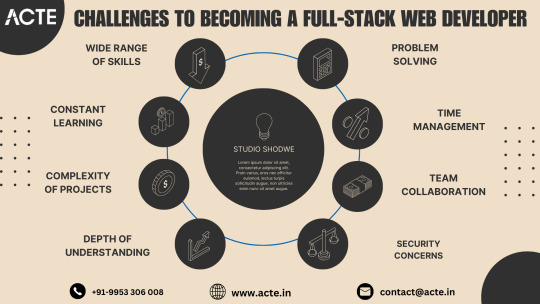
5. Effective Problem Solving
Effective problem-solving is a hallmark of successful full-stack developers. Debugging code, identifying bottlenecks, and optimizing performance demand astute analytical skills and a systematic approach. Collaborating with peers, leveraging online resources, and seeking mentorship can facilitate the navigation of complex technical hurdles and yield effective solutions.
6. Strategic Time Management
Balancing multiple responsibilities, including frontend and backend development, database management, and project deployment, necessitates adept time management skills. Prioritize tasks, establish realistic timelines, and leverage productivity tools to streamline your workflow and maximize productivity. Reserve time for ongoing learning and professional development to continually enhance your skill set.
7. Cultivating Team Collaboration
Full-stack developers often collaborate with interdisciplinary teams, comprising designers, frontend developers, backend developers, and other stakeholders. Effective communication, teamwork, and collaboration are vital for project success. Foster strong interpersonal relationships, actively contribute in team settings, and cultivate a culture of open communication and collaboration within your team.
8. Prioritizing Security
Understanding security best practices and implementing robust security measures is paramount in web development. Full-stack developers must remain vigilant in identifying and mitigating security vulnerabilities to safeguard sensitive data and uphold the integrity of web applications. Stay informed about prevalent security threats, adhere to industry best practices, and consistently update your knowledge to proactively address emerging risks.
Conclusion
Embarking on the journey to becoming a full-stack web developer is a thrilling endeavor marked by challenges and triumphs. By embracing the obstacles, refining your skills, and maintaining a steadfast commitment to learning and growth, you can unlock a realm of opportunities and embark on a gratifying career in web development. Remember, each challenge surmounted brings you closer to mastery, and the journey itself is as enriching as the destination.
#full stack developer#education#information#full stack web development#web development#front end development#full stack developer course#technology#backend
2 notes
·
View notes
Text
Bleach OC - Name Games
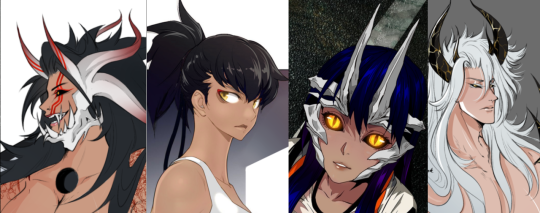
Ibaraki [伊原木] Tomoe [永萌]
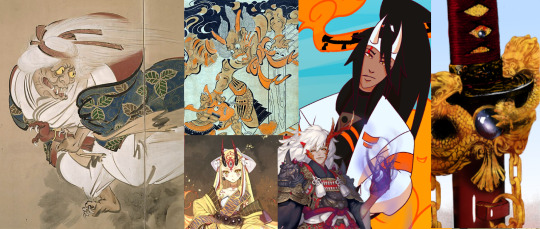
Ibaraki [伊原木]
伊 (I): A phonetic element, providing the name with a certain sound or rhythm. Can be used as a pronoun, "he/she/it", "this/that", "just". (Also used as a stand alone to mean 'Italy' which is completely irrelevant here.)
原 (Hara): This character means "meadow/field/plain/prairie", "original", "primitive", "tundra", and "wilderness." It is often associated with nature, open spaces, or the beginning or source of something. In personal names, it can evoke a sense of groundedness, natural beauty, or an ancestral connection. (Most famously in Bleach, this kanji is the same as used in 'Urahara' [浦原], of which it seems to derive no special meaning.)
木 (Ki): This character represents "tree" or "wood." It symbolizes strength, growth, and vitality. It can also be associated with qualities such as stability, flexibility, and a connection to nature.
This name has little upfront meaning, and there isn't a widely recognized symbolic interpretation of it. It's most recognizably the name of Ibaraki Prefecture, however the kanji used for that is 茨城, roughly "thorny castle". Where as Tomoe's Ibaraki "伊原木" might be more aptly read as "that original tree" (as "that field of wood" makes little sense".)
Further, I admit it was chosen a little haphazardly. Tomoe was originally written as a sister to Tatsuki, and thus used her surname 'Arisawa' but due to the tastes of tumblr RP and my own development of this muse, she eventually diverged from this original form and needed a new name to accompany it. The name, consequently, wasn't picked with a specific meaning in mind.
Rather it was picked due to the use of its name for Ibaraki-doji, a supernatural entity depicted as a grotesque, one-eyed, hag-like creature with long, disheveled hair in Japanese folklore. It can be described in certain folklore as an Oni or Oni like creature. The Ibaraki-doji is known for its mischievous and sometimes malevolent behavior.
This is an obvious connection with Tomoe's own Oni symbolism of her inner hollow, however closer readings of Ibaraki-doji's folklore would be necessary to gain a deeper understanding of Tomoe herself.
For example, many tales of Ibaraki-doji often focus on:
Transformation and Hidden Nature
Feminine Power and Rebellion
Morality and Consequences
Exploration of Otherness and Otherworldly Beings
All of which are major themes of this blog, and which I might return to touch on at a later time, but this post is already getting SO LONG, and I still have to talk about her first name.
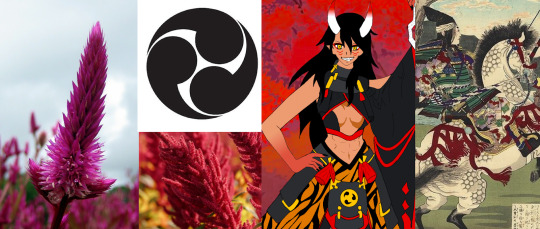
Tomoe [ 永萌 ]
永 (nagai/ei) - This character represents "eternity" or "perpetuity." It conveys the idea of something enduring or everlasting.
萌 (moe) - This character has multiple meanings, but in the context of the name "Tomoe," it is often associated with "sprouting," "budding," or "to be full of life." It can represent the concept of new growth, vitality, or the awakening of potential.
When combined, the kanji "永萌" in the name "Tomoe" can be interpreted in several ways:
Eternal Sprout: The name can signify a continuous, evergreen presence of growth and vitality, suggesting an enduring and lively nature.
Everlasting Potential: It represents the idea of unceasing potential or the perpetual capacity to bloom and develop.
Eternal Awakening: The name may convey the concept of an eternal awakening or the continuous realization of one's inner self.
In the context of Tomoe, herself and my creation of her, I leaned into the last two meanings, with a preferential reading of 'Everlasting Potential'. Her name represents the idea of enduring possibilities, growth, and the constant realization of one's capabilities. It can be seen as a name that embodies the concept of ongoing development, resilience, and the ever-expanding horizons of one's potential - a concept that's tied into multiple other parts of her design including the inclusion of:
Amaranthine - from the word "amaranth," which refers to a group of plants known for their vibrant, long-lasting flowers. When discussing flower symbolism, the term "amaranthine" often represents enduring beauty, immortality, and eternal love and this meaning is preserved both in the name of this blog (though I've recently considered changing it), as well as in Demonio's design, which features a changing tattoo of flowers on her skin. While the flower motif doesn't crop up frequently on this blog it is one that should be kept in mind.
Amatsu-Mikuboshi - Amatsu-Mikaboshi is a deity in Japanese mythology and Shinto cosmology. In Shinto belief, Amatsu-Mikaboshi is associated with darkness, chaos, and the unseen forces of the universe, and often placed in juxtaposition to Amaterasu. It is an opposing force that must be carefully tempered by the other gods, and while he can be suppressed or contained, he cannot be killed or defeated. The universe maintains its careful balance between order and chaos.
Her Age - She's a character that is designed to look at personal growth, how one develops and grapples with challenge. Since her creation she's aged several years. No longer a child, this is a character that's had to face great adversity and transformation in order to develop into the woman she is at this day.
However, while this understanding of Tomoe's name is one of the conventional meanings, 萌 (moe) may also be used in certain contexts to mean 'to show symptoms of'. This usage is more commonly seen in medical or clinical contexts rather than as a standalone name. In medical terminology, it can be used to describe the manifestation or appearance of symptoms or signs of a condition. While this is not a meaning that would be used when discussing stand alone names, a non-conventional reading of "Tomoe" (永萌), may be translated as "to show symptoms of eternity" based on the literal meanings of the individual kanji characters.
In this sense, her name reflects, quite literally, her curse of immortality bestowed upon her by Amatsu-Mikaboshi, and the ability which will allow her to act as its avatar and the executor of its will.
Tomoe (巴) is also the name of the comma like shape and is a motif I've used in her design previously, which also ties in to her themes of spirituality. It’s a common symbol used in shinto design, as well as regarded for its protective properties. Further, the swirling motion of the tomoe shape can symbolize change, transformation, and the continuous flow of life. It represents the cyclical nature of existence and the ever-changing world.
Finally, the name is shared by another famous figure of Japanese history: Tomoe Gozen. Though the kanji differ, one can't help but think of the celebrated and renowned female samurai when one hears it, and the implication I hope it invokes for Tomoe Ibaraki is that of a loyal and devoted warrior.
In sum the final reading of her name and the images it evokes is one of conflict, and a battle between good an evil, order and chaos. Homonyms with both heros and demons, and evoking imagery of potentially limitless growth, and expansion, her name embodies many of the themes her character grapples with.
#headcanon ;; 👹#yall i put so much effort and thought into my muses and Yall dont even KNOW#tomoe is by far one of my least cleverly name muses (i think the prize goes to megumi's zanpakuto personally) but i put SO MUCH BRAIN INTO#i love her#pls dont mind me FULLY stealing littleeyesofpallas' format for this post#it was obviously completely inspired by their work#they were the one who enlightened me to the intricacies of bleach names so hopefully i lived up to Kubos standards#only took me like 4 hours to write this im SO SLOW
8 notes
·
View notes
Note
God, it sucks that people can lack such basic respect for you and your characters, I’m so sorry. Like, it shouldn’t be so hard for people to respect Cody’s pronouns when they’re literally right there??
And on top of that making the AI bot thing of Cody and training it to misgender them, like…what the fuck??

unfortunately, that is often the case with nonbinary characters. people will sometimes mentally filter out the they/them and fill in "the blank" with their own personal biases of how the character's design should be interpreted.

the only thing i can do is quietly correct people who misgender them by modifying their ask before it reaches post, so that there is no canonical instance of people misgendering cody, even if those askers do so behind the scenes.
i hold no grudges against the people who do this (i do believe it to be a genuine mistake and not intentionally malicious) - however, it is something that i openly disapprove of.
being agender myself, it always stings a little bit when an agender character i create is also misgendered.

as for the AI, the misgendering is just insult to injury, and is not my primary concern.
i have openly stated here that cody is my personal OC (not a public-domain pokepasta character), and that i did not want an AI of them to be created.
maybe the person who created it does not follow my main, and is only consuming pkmn-monochrome content through the ask blog alone. if that is the case, then i can understand how they might have missed me explicitly prohibiting people from doing this.
however, the absence of a visible "no" is not a "yes", and to see my character taken and treated like any other pokepasta character whose creator is anonymous and uncontactable is completely unacceptable.
pkmn-monochrome is an ongoing story who has a real person behind it who works on it daily as an active presence. i am not untouchable, i am here and able to be asked permission - if not on my personal blog, then on the monochrome blog as well.
i work very hard to ensure that cody's character is portrayed respectfully and consistently, and to see that work be undermined and parodied by a machine that was trained by someone with a very flawed understanding of the character is beyond insulting.
it is very harmful to my work, as those who roleplay with the bot will be given no context on what story cody is from or who it belongs to, and will be given an inaccurate and damaging portrayal of my character.
(the AI misgendering them also perpetuates the misgendering of the character even further, as well.)

my apologies for taking your ask as an excuse to rant about the issue.
as you can tell, i am still very frustrated by this. thank you for your ask.
14 notes
·
View notes
Text
Also in b4 someone suggests that I would prefer to have halacha decide the rules of marriage and divorce for everyone instead: lmao no I fucking wouldn't.
I say this with profound love for Am Yisrael, Medinat Yisrael, and our religious tradition, but the traditional halacha of kinyan and gittim are a hot mess in the year of our Lord 5783. While many of those rules were originally designed to protect the financial security of women and came from a good place, many if not most were decided back when (1) women were property, (2) children were property, (3) non-familial forms of slavery were completely normal, and (4) adultery was punishable by stoning.
Trouble is, a lot of the original language and setup has been preserved and not enough has evolved with changing social conditions. So, today, rules that were originally about protecting women are still about a Jewish man "acquiring" a Jewish woman for a wife and divorce is still only technically permitted by permission of the man, creating and perpetuating the ongoing agunah crisis.
A separate but connected problem is that (to the best of my knowledge) the Rabbinate controls marriage and there is no secular marriage in Israel, so fuck you if you want to marry in an egalitarian, secular, queer, and/or interfaith way unless you literally leave the country to do it. (Israel will recognize these marriages from other jurisdictions.)
Tl;dr -
Even though there are plenty of people within the community working on it, there is still a lot to criticize about the halacha of marriage and divorce, and the way Israel handles it currently, and so nope, wrong, try again, religious law should not be applied to secular family law, even if it's mine.
29 notes
·
View notes